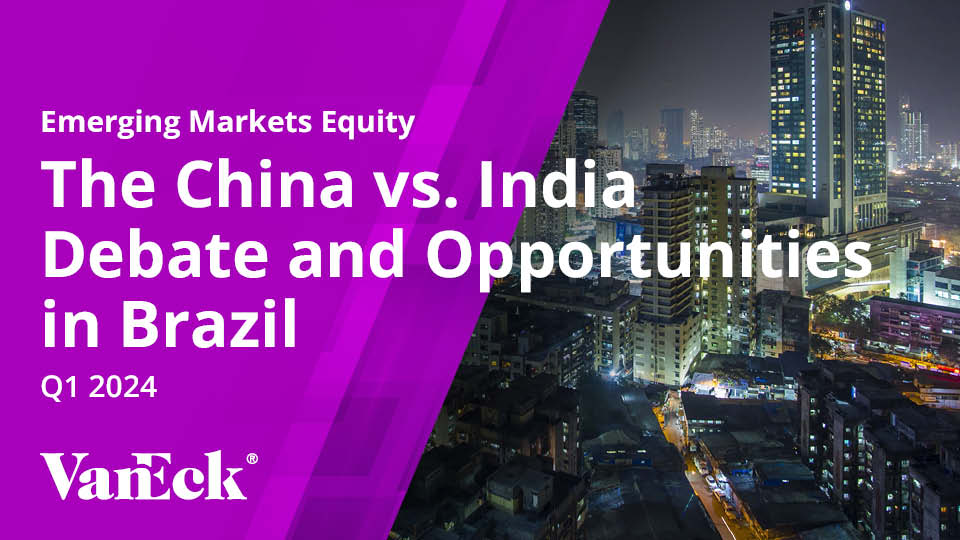Structural Growth to Regain Luster, After Style Rotation Calms
23 April 2021
Share with a Friend
All fields required where indicated (*)During the first quarter, many aspects of economic activity in emerging markets (EM) returned to a semblance of normality, despite varying Covid-19 experiences. Whilst vaccination will generally be behind the pace of developed markets (DM), conventional monetary policy and lower fiscal support, compared to DM, bodes well for decent economic growth over the next several years. The success in vaccinations in the U.S., aided and abetted by truly remarkable and costly fiscal stimulus, is engendering a rehashed narrative of American economic exceptionalism, just as China pursues a more prudent course.
Inflation expectations have become a concern for all investors. We see this as principally the U.S. concern and our observations on disruption and debt dynamics lead us to the conclusion that sustained inflation into 2022 is unlikely to be a major concern. In our view, it is more likely that global central banks will continue to compress business and capital market cycles, hindering the extrapolation of the current reflationary “trade.” Essentially, digitalization, disruption, demographics and the changing nature of employment make us skeptical that the Phillips curve1 will work and we believe that as we enter the second half of the year, the reflationary trade will increasingly be seen to be a case of “buy the rumor and sell the news.”
China’s economy continues to consolidate its post-Covid recovery, with what appears to be strong internal and external economic numbers. Year-on-year numbers are challenging, in part due to lapping the initial stages of the lockdown and the annual challenge of incorporating the lunar new year which takes place on differing dates. Careful analysis reveals a solid economic story but, as history shows, with potential challenges. The rise of leverage ratios has been a source of concern for some observers for a number of years now. We do not dismiss this concern but we believe it is well understood and monitored. As an added stress factor, China-U.S. relations continue to be running sore. Whilst the communication has improved and the negative trajectory is less worrisome, there are real challenges ahead, giving some investors pause, despite indubitably exciting investment opportunities, particularly relating to China’s domestic demand. We have spent a great deal of time analyzing domestic demand, structural growth companies that are taking market share from foreign competitors. We think that this is a rich vein to tap and we see forward-looking, sustainable and structural growth opportunities in both the consumer and industrial sectors. We also see some fundamentally exciting investment opportunities in certain sectors that have sold off due to concern about regulatory action. These pockets of alpha exist in areas such as internet, local services and education.
The remainder of EM Asia continues to recover, though with considerable differentiation across the region. In general, northeast Asia has outperformed due to the following factors: better virus control measures, relatively more exposure to global demand for tech products and less to virus-sensitive sectors such as tourism and less sensitivity to rising dollar yields.2 India is suffering a further bout of Covid infection, necessitating another tightening of mobility restrictions. We are not particularly concerned about this in the long run but we do think that, in general, valuations leave a little less room for error than some other markets.
In LatAm, the real business cycle recovery has softened on the back of a rising second wave of the pandemic, which led the authorities in many countries to reinstate stricter social distancing and activity protocols. Even Chile, which has been far ahead of its neighbors in terms of vaccinations, has seen a resurgence of Covid and further mobility restrictions. In Brazil, economic activity has recovered but with depressing predictability - political noise has affected the market. Regionally, we expect the recovery to strengthen during 2H2021 as a result of gradual broadening of ongoing vaccinations, accommodative financial policies, firmer terms of trade and an overall supportive global growth backdrop.3
With regards to CEEMEA,4 it is a mixed picture. The economies with a higher beta to commodity prices (i.e., Russia and South Africa) have fared reasonably well, even as there are increased concerns about new Russian sanctions. Turkey scored a bit of an own goal, as the country’s President, Recep Erdoğan, replaced the central bank governor just as he was about to establish an increased monetary credibility. Meanwhile, the unacceptably slow EU vaccination effort has weighed upon the economies of Eastern Europe.
Emerging Markets Equity Outlook: Optimism Continues into 2021
We continue to be optimistic about the emerging markets outlook for 2021 and beyond. We see considerable potential for strong growth ahead, boosted by Covid-19 vaccine availability, catalyzing a return to “normal” in EM economies, albeit at a slower pace for some. Inflation will likely return to lower levels and rates will likely stay at relatively accommodative levels.
This is a conducive environment for investments in companies that represent structural growth at a reasonable price. In many respects, we occupy the middle ground between unjustifiable valuations for long duration, high growth stocks and the “moment in the sun” value trades that have become the new momentum. We spend our time interacting with and analyzing forward-looking, sustainable, structural growth companies that we believe have strong prospects and are led by capable and credible management teams. We do not frantically toggle between styles to try to capture market zeitgeist. We believe that staying true to our style, with persistence and discipline, will be rewarding over the medium and longer term. Investing in emerging markets is for the long haul. Whilst we can’t say exactly how all businesses will recover, we can say, with conviction, that the Fund is well positioned for the future of emerging markets.
1 The Phillips curve states that inflation and unemployment have an inverse relationship: higher inflation is associated with lower unemployment and vice versa. The Phillips curve was a concept used to guide macroeconomic policy in the 20th century but was called into question by the stagflation of the 1970's. Understanding the Phillips curve in light of consumer and worker expectations shows that the relationship between inflation and unemployment may not hold in the long run, or even potentially in the short run.
2 Source: Goldman Sachs Economics Research. Data as of 20 March 2021.
3 Same as above.
4 Central and Eastern Europe, Middle East and Africa.
Important Disclosure
This is a marketing communication. Please refer to the prospectus of the UCITS and to the KID before making any final investment decisions.
This information originates from VanEck (Europe) GmbH, which has been appointed as distributor of VanEck products in Europe by the Management Company VanEck Asset Management B.V., incorporated under Dutch law and registered with the Dutch Authority for the Financial Markets (AFM). VanEck (Europe) GmbH with registered address at Kreuznacher Str. 30, 60486 Frankfurt, Germany, is a financial services provider regulated by the Federal Financial Supervisory Authority in Germany (BaFin).
The information is intended only to provide general and preliminary information to investors and shall not be construed as investment, legal or tax advice VanEck (Europe) GmbH, VanEck Switzerland AG, VanEck Securities UK Limited and their associated and affiliated companies (together “VanEck”) assume no liability with regards to any investment, divestment or retention decision taken by the investor on the basis of this information. The views and opinions expressed are those of the author(s) but not necessarily those of VanEck. Opinions are current as of the publication date and are subject to change with market conditions. Certain statements contained herein may constitute projections, forecasts and other forward-looking statements, which do not reflect actual results. Information provided by third party sources is believed to be reliable and have not been independently verified for accuracy or completeness and cannot be guaranteed. Brokerage or transaction fees may apply.
All performance information is based on historical data and does not predict future returns. Investing is subject to risk, including the possible loss of principal.
No part of this material may be reproduced in any form, or referred to in any other publication, without express written permission of VanEck.
© VanEck (Europe) GmbH / VanEck Asset Management B.V.
Sign-up for our ETF newsletter
Related Insights
Related Insights
16 April 2024
15 April 2024
04 March 2024
12 February 2024
01 February 2024





